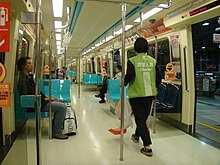
Back النشاط البدني Arabic Activitat física Catalan چالاکیی فیزیکی CKB Körperliche Aktivität German Actividad física Spanish Kehaline aktiivsus Estonian Jarduera fisiko Basque فعالیت فیزیکی Persian Fyysinen aktiivisuus Finnish Activité physique French

Physical activity is defined as any voluntary bodily movement produced by skeletal muscles that requires energy expenditure.[1] Physical activity encompasses all activities, at any intensity, performed during any time of day or night.[2] It includes both voluntary exercise and incidental activity integrated into the daily routine.[3] This integrated activity may not be planned, structured, repetitive or purposeful for the improvement of physical fitness, and may include activities such as walking to the local shop, cleaning, working, active transport etc. Lack of physical activity is associated with a range of negative health outcomes, whereas increased physical activity can improve physical and mental health, as well as cognitive and cardiovascular health.[4] There are at least eight investments that work to increase population-level physical activity, including whole-of-school programmes, active transport, active urban design, healthcare, public education and mass media, sport for all, workplaces and community-wide programmes.[5][6] Physical activity increases energy expenditure and is a key regulator in controlling body weight (see Summermatter cycle for more).[7] In human beings, differences among individuals in the amount of physical activity have a substantial genetic basis.[8]
- ^ Global Recommendations on Physical Activity for Health, 2009. World Health Organization. Geneva, Switzerland. Accessed 13/07/2018. Available at: http://www.who.int/ncds/prevention/physical-activity/en/
- ^ Pedišić, Ž. (2014). Measurement issues and poor adjustments for physical activity and sleep undermine sedentary behaviour research—the focus should shiftep, sedentary behaviour, standing and activity. Kinesiology, 46 (1), 135-146. Retrieved from https://hrcak.srce.hr/123743
- ^ Garland, Jr., T.; Schutz, H.; Chappell, M.A.; Keeney, B.K.; Meek, T.H.; Copes, L.E.; Acosta, W.; Drenowatz, C.; Maciel, R.C.; van Dijk, G.; Kotz, C.M.; Eisenmann, J.C. (2011). "The biological control of voluntary exercise, spontaneous physical activity and daily energy expenditure in relation to obesity: human and rodent perspectives". Journal of Experimental Biology. 214: 206–229. doi:10.1242/jeb.048397. PMID 21177942.
{{cite journal}}: CS1 maint: multiple names: authors list (link) - ^ Ione Avila-Palencia (2018). "The effects of transport mode use on self-perceived health, mental health, and social contact measures: A cross-sectional and longitudinal study". Environment International. 120: 199–206. doi:10.1016/j.envint.2018.08.002. hdl:10044/1/62973. PMID 30098553. S2CID 51965322.
- ^ Fenech, Amanda; Chockalingam, N.; Formosa, C.; Gatt, A. (1 January 2021). "Longitudinal effects of evidence-based physical education in Maltese children". Child and Adolescent Obesity. 4 (1): 98–116. doi:10.1080/2574254X.2021.1915041. S2CID 237846270.
- ^ Milton, Karen; Cavill, Nick; Chalkley, Anna; Foster, Charlie; Gomersall, Sjaan; Hagstromer, Maria; Kelly, Paul; Kolbe-Alexander, Tracy; Mair, Jacqueline; McLaughlin, Matthew; Nobles, James (2021-05-12). "Eight Investments That Work for Physical Activity". Journal of Physical Activity and Health. -1 (aop): 625–630. doi:10.1123/jpah.2021-0112. hdl:1983/8805dde9-3053-4103-aa70-314da5fd30cc. ISSN 1543-5474. PMID 33984836.
- ^ S, Summermatter; C, Handschin (November 2012). "PGC-1α and Exercise in the Control of Body Weight". International Journal of Obesity. 36 (11): 1428–35. doi:10.1038/ijo.2012.12. PMID 22290535. S2CID 26821676.
- ^ Lightfoot, T.J.; De Geus, E.J.C.; Booth, F.W.; Bray, M.S.; den Hoed, M.; Kaprio, J.A.; Kelly, S.A.; Pomp, D.; Saul, M.C.; Thomis, M.A.; Garland, Jr., T.; Bouchard, C. (2018). "Biological/genetic regulation of physical activity level: consensus from GenBioPAC". Medicine and Science in Sports and Exercise. 50: 863–873. doi:10.1249/MSS.0000000000001499. hdl:1871.1/1e989997-ac6e-4dfe-845f-625b67a4a8df. PMID 29166322.
{{cite journal}}: CS1 maint: multiple names: authors list (link)